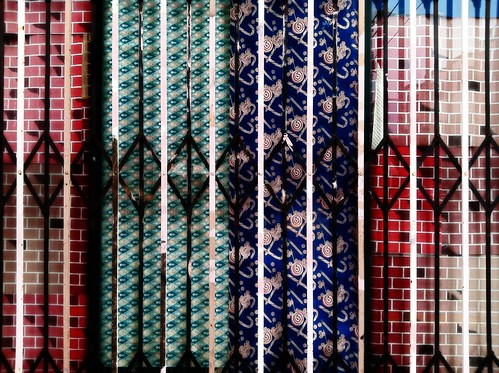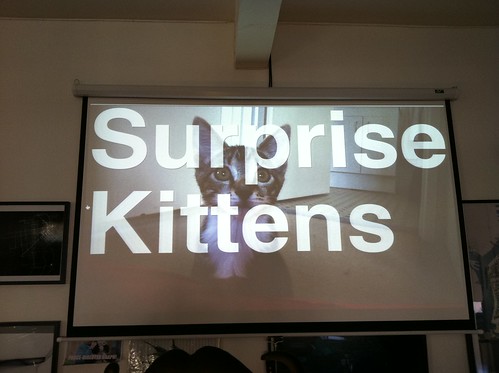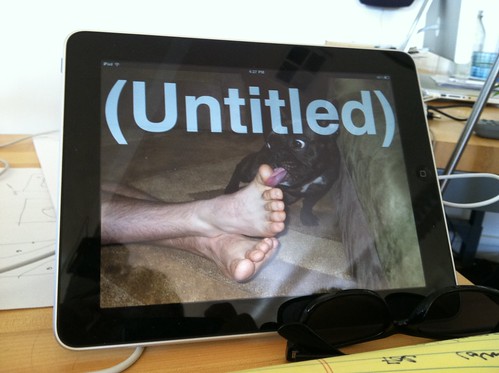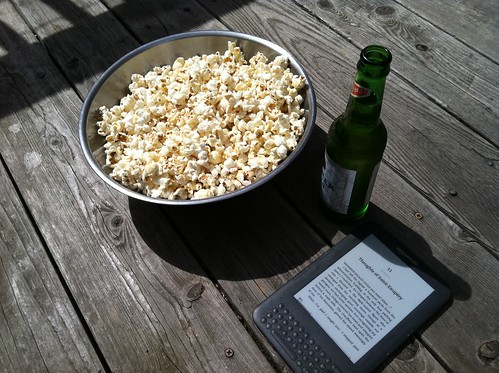Pua
Last Thursday, Neil Walker quietly pressed the deploy button on new API methods that allow applications to receive a stream of new and updated photos (and faves) from your contacts on Flickr. I was fortunate enough to help Neil with this and to build the patient zero (technically patient one but that's another story) API application: I wrote about it, a little, last May in a fuzzy story about a dog and a leg.
The PuSH stuff from Flickr is a big deal. It doesn't provide the full kitchen-sink of search options that people have gotten used to with the Flickr API and it errs on the side of being conservative when it comes to private or not-marked-safe photos because those are still hard questions and there's no putting the paste back in the tube. But it works. It works at a scale that no one has been able to do before and it makes possible all kinds of applications that have either been impossible or so annoying to build that they might as well be impossible.
There's been a lot of talk these days about the crustiness of the photos from your contacts
page on Flickr. It shouldn't come as any surprise to anyone that I've long been in that camp having written Flickr For Busy People (FFBP) a few years ago. The value of the PuSH API methods is that they open up the space of possible applications like FFBP or Contacts Who've Faved (CWF) without being so prescriptive about how the API queries the database and returns search results. In fact it makes it possible to rewrite both of those applications to be better, more flexible and more reliable than they are today. It means that some of the burden of sorting photos is pushed back down to the application developer but that seems like a small price to pay for the ability to play with Flickr as it happens.
Neil has spent his time building out some pretty impressive plumbing that makes possible a leveling out of the load, the demand, that applications place on the Flickr servers (and by extension all the people who work there) which makes it possible for more people to do more awesome stuff more often.
I built a variation and a smushing together of both FFBP and CWF. It's called Pua
and is still an invite-only thing but it has an about page and this is what it says:
Why did you do this?
Somewhere in Flickr's seven and a half history there is this absurd notion that's taken hold which says Flickr is only for good
photos. In fairness, there are a few reasons why that narrative lives on:
Flickr was blessed early on with the arrival, in droves, of people who take seriously the art and craft of photography; Flickr promoted the idea both of an Interestingness metric and an Explore section as a way to highlight even just a slice of all the amazing stuff that is uploaded to the site every day which had the perverse effect of creating a Frankenstein leaderboard cult and an unintended narrowing of people's expectation of what it means for a photo to be good; Flickr hasn't done as a good a job as it coulda-woulda-shoulda keeping up with the pace at which people in their immediate social circles are taking and sharing photos (that shift, from nerdy minority to basically everyone, happened almost overnight with the arrival of cheap and ubiquitous data plans bundled with cameraphones) allowing itself to be painted in to a corner where it looks and feels like a capital-G gallery with all the unfortunate expectations that come with that designation.
But still, this insane measure of good
-iness against which everything is judged gets under my skin every time I hear about it. Somewhere between the Hell of HDR photos of sunsets (on beaches (with babies (playing with puppies))) and a barren post-modern world devoid of any critical interpretation lies the territory where most of us live our lives trying to eke out rare moments of beauty in the shifting shadows. Somewhere in there we make a meaning for ourselves that has its roots in how those images shape themselves to the big-little bags of history we all trail behind us while we're otherwise busy trying to be noticed. That is where the magic — the good — happens.
Stewart summed it up nicely, way back in 2006, in his Eyes of the World blog post:
That can manifest itself as art, or using photos as a means of keeping in touch with friends and family,
personal publishingor intimate, small group sharing. It includesmemory preservation(the de facto understanding of what drives the photo industry), but it also includes the ephemera that keeps people related to each other: do you like my new haircut? should I buy these shoes? holy smokes – look what I saw on the way to work! It let’s you know who’s gone where with whom, what the vacation was like, how much the baby grew today, all as it's happening.And most dramatically, Flickr gives you a window into things that you might otherwise never see, from the perspective of people that you might otherwise never encounter.
It's the as it's happening
part that's suffered until now due in no small part to the sheer big-iness of Flickr and the necessary plumbing to make the broadcasting of photos in real-time possible, at all. But here we are now and one of the things it makes possible is an even bigger window with which a person can look on the world. It's not rocket science: It broadens the opportunities to see more photos and to encourage the time and the space with which we might use them to create moments of poetry.
Pua is the evolution of a similar application called Contacts Who've Faved (cwf) whose starting premise is: I don't really care what an algorithm or even the majority of Flickr users think is a worthwhile photo but I am more than interested in pictures that my contacts, be they friends or simply strangers whose photos I enjoy, have fallen in love with. I add people as contacts now simply to see the photos they fave. cwf favours a minimalist interface — thumbnails and coloured squares to represent the user who faved the photo — because it's meant to emphasize, to make more inviting than anything else, the form and colour and composition of the images themselves.

Pua takes that idea one step further and shows you nothing but a continuous stream of images, scaled to fill the entire screen, with their titles overlayed in big friendly letters. The funny thing about Pua is that, because it is always on and sitting quietly next to me, I both see more photos than I normally would and feel less anxious about the idea that I've somehow missed out on what people are doing because photos that would otherwise fall through the cracks has a lovely way of bubbling back up as people comment on them or they are faved or even just have their title changed.
Pua is not about trying to drink from the proverbial firehose of everything happening right now because the only meaningful consequence of trying to do it is that you hurt your lips. It tries, instead, to be a gentle glimpse into the looking glass of other people's lives and what they imagine to be meaningful or good
.
Pua owes a debt of inspiration to the work that the clever people at RIG have been doing with similar projects including DEXTR and Romance Has Lived Too Long Upon This River and to Dan Catt for his work making newpaper headlines fun again. Chris Thorpe also has a really good blog post about glanceables
(much as I loathe the term itself) and what we imagine is possible doing with all these spare screens that have already started becoming a constant presence in our lives.
For the time being Pua remains an invite-only thing. I'd like to open it up to everyone but it's a thing that I wrote largely for myself in the margins of the day and I'm not quite ready to accept the burden (the fear) of being woken up at three in the morning to babysit a server. There was a small bump in the number of invite requests after Neil's blog post. They've all been accepted and Pua seems to be humming along fine so if you want to play drop me a line over here and I'll send you an invite code.
Also, untitled moments are the best:
This blog post is full of links.
#puaOn touching — and rubbing up against — broken things
There is a practice in both civil and common law where past cases establish tests
used to determine the arguments or the justification of future cases. I asked a friend who is a lawyer about it and he said:
...this practice of establishing tests does not, as far as I know, have a name. It follows as a consequence of the doctrine of precedent - I.e., that a previous case should be followed, this doctrine is called stare decisis.
Often these tests are not conclusive — just a list of indicia. This is especially true in Canada where the Supreme Court loves to province non-limitive lists of "factors to consider". See for example the useless Baker test...
I like the phrase a list of indicia
. It's a good way to describe the first pass of a filter you use to block out an idea the way classical sculptors would begin a work in stone.
Public policy wonks do something similar where it sometimes causes people to argue of behalf of some pretty nutty proposals in the service or a particular moral argument. The example I always cite states that a country like Mexico should stop growing corn (one of the bedrocks of its cultural identity) because its production output
is not as efficient as other countries and really the long-term goal is to feed the world's under-nourished by whatever means necessary.
I mention that because it seems like it would be useful to have a similar set of tests, or proofs to validate, where anyone claiming to talk about a breathless and magic future world is forced to pass their ideas through the meat grinder prism of a J.G. Ballard novel and the re-evaluate everything they've said in the light of what they might imagine coming out the other end.
I suppose this has always been the science fiction writer's claim and lament, hasn't it Myles?
On the heels of finishing Greg Lindsay's Aerotropolis
I read Ballard's Super Cannes
which is not an awesome novel but cast a useful shadow not so much on the Rainbow Pony Airport City described in Lindsay's book as it did on the social and physical and emotional machinery that needs to built in order to accomodate it.
There are some common themes that run though all of Ballard's books not least of which is the jigsaw puzzle relationship he is always piecing together between crushed metal objects and the ways in which people can accomodate their naked bodies to them. And the character of the Minotaur always played by an overbearing father figure whose deeper meaning and recurring presence I'll leave to the English lit majors and the Freudians in the crowd.
Overall it's a weird set of devices to use to try and understand the motivations that govern our actions. Super Cannes
seems not so much about airplanes as the gated corporate communes those machines and the airports, that Lindsay writes about, give birth to and the freakish culture of performance (and luxury) that has followed and which sometimes seems like its as much a coping mechanism for the September 11th attacks as anything else. It's a doubly curious proposition knowing that the book was published in the year 2000 and it's more about the whispering sounds that the curvatures of an infrastructure — the lists of indicia — present for people to rub themselves against, given the opportunity, than it is about arguing happily ever after.
Just like the last time what follows are the passages I underlined while reading the novel, preserved here because there is still no better alternative. It occurred to me that an interesting alternative would be to set up a Twitter account and push out the interesting bits as they're being read. It might get old and bothersome for people on the receiving end (and I'm sure someone would take it upon themselves to rebroadcast a book in its entirety) but the upshot might be someone approaching the possibilities in the same way Maureen embraced the constraints of an abbreviated text when she set up the @cookbook account.
Maybe one day Amazon and others will make that possible from inside their future-pants reading devices but in the meantime...
a kind of waiting madness, like a state of undeclared war
#123In its way this is a huge experiment in how to hothouse the future.
#316It's not so much their craft skills as their attitude to an entirely new workplace culture.
#322We've concentrated on the office as the key psychological zone.
#346The sticky bowl had trapped a small insect
#506Ambitious dentists did not complain about the poor oral hygiene of their richer clients.
#578the satellite dishes draining information stored in the sky.
#660Ornamental pathways led to the electricity substations feeding power into the business park's grid.
#669An invisible infrastructure took the place of traditional civic virtues.
#684Civility and polity were designed into Eden-Olympia, in the same way that mathematics, aesthetics and an entire geopolitical world-view were designed into the Parthenon and the Boeing 747.
#687It rose and fell, manipulated by someone tired of the darkness but unimpressed by the possibilities of the day.
#711this failure of a comfortable reality.
#888I stood by the pool's edge, and searched the deep water.
#1040its moral thermostat
#1291the scar from her nasal ring concealed with cosmetic filler.
#1324The pressure of Jane's mouth still dented my lips as I walked to the car.
#1365If you want real crime, go to Nice or Cannes La Bocca. Robbery, prostitution, drug-dealing – to us they seem almost folkloric, subsidized by the municipality for the entertainment of tourists.
#1405filing the tragedy in some administrative limbo assigned to earthquakes and regicides.
#1474Crime could flourish at Eden-Olympia without the residents ever being aware that they were its perpetrators or leaving any clues to their motives.
#1479She had left a mess of debris, tissues stained with coffee, cream spilt onto the paper cloth. Were bad table manners a quirk of Eden-Olympia's executive class, a safety valve for corporate tensions?
#1528Unless you own a Ferrari, pressing the accelerator is not a moral decision. Ford and Fiat and Toyota have engineered in a sensible response curve. We can rely on their judgement, and that leaves us free to get on with the rest of our lives. We've achieved real freedom, the freedom from morality.
#1590In many ways I'm a kind of leisure coordinator. I run the adventure playground inside their heads.
#1603De Sade's behaviour was typical of his class. Aristocracies keep alive those endangered pleasures that repel the bourgeoisie. They may seem perverse, but they add to the possibilities of life.
#1610He didn't realize that the French see the Alice books as a realistic picture of English life.
#1631dreams equipped with airbags
#1728The heat rose from the ornamental tiles like a headache
#1813as if the car was a huge orthopaedic device that expressed a voluptuous mix of geometry and desire
#1971the ground beneath them so crammed with electronic ducting that no roots could prosper
#2216reestablishing her tenancy of this segment of space-time
#2266They were dressed in the chocolate-coloured uniforms favoured by supermarket security men. When they saluted, it struck me that this would be the chosen costume of any future army ordered to pacify a civilian population, reminding it of happier days spent in the confectionery aisles.
#2459"There's no civic sense here." "There is." Halder pointed to a nearby surveillance camera. "Think of it as a new kind of togetherness."
#3034The sea was smooth enough to xerox
#3513I read medicine out of a need to be like him, and then became a psychiatrist to understand why.
#3983There are none of the social tensions that force us to recognize other people's strengths and weaknesses, our obligations to them or feelings of dependence.
#4198Once you dispense with morality the important decisions become a matter of aesthetics.
#4212This was an Eden without a snake.
#4250We aren't running an adventure playground, but a forcing house designed to expand the psychopathic possibilities of the executive imagination.
#4301Without realizing it, the crowds under the palm trees were extras recruited to play their traditional roles
. #4514They waved like novice queens at the crowd, aware that they had crossed the threshold where celebrity and the illusion of celebrity at last fused for a few exhilarating hours.
#4522One of them was trying to smile, and a strange crevice appeared in the area of her mouth, a vent of hell.
#4677The residents of the high-security complex might have retreated so deeply into their defensible space that they had eliminated the need for d
, #5290We passed a shallow tank filled with lobsters, sidling around each other like airliners looking for a runway.
#5310
This blog post is full of links.
#rubbing



